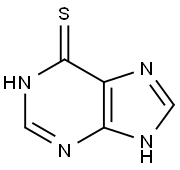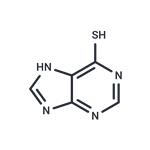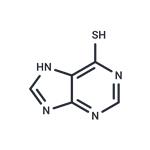Chemical Properties
Yellowish-Greenish Solid
Originator
Purinethol,Sandoz,France,1950
Uses
6-Mercaptopurine (6-MP) is a antineoplastic,
immonusupressant; inhibits purine nucleotide synthesis and metabolism. 6-MP have been used for
several decades in the treatment of leukemia
and certain other neoplastic diseases. 6-Mercaptopurine is used for maintenance
therapy of acute lymphocytic and acute myelogenous leukemia.
Uses
Has a cytotoxicity effect
Definition
A sulfurcontaining purine base not found in animal
nucleoproteins.
Manufacturing Process
7.5 g of 4-amino-6-chloro-5-nitropyrimidine was suspended in 200 ml of 1 N potassium hydrosulfide and heated on the steam bath for 2 hours while passing hydrogen sulfide through the reaction mixture. The reaction mixture was allowed to cool slowly, acidified with 10 N sulfuric acid and chilled. The precipitate consisted of 4,5-diamino-6-mercaptopyrimidine and sulfur. It was boiled with 300 ml of water, filtered hot and then chilled. The product precipitated as pale yellow needles (4.2 g); an additional 0.95 g was obtained by concentration of the mother liquors to 100 ml.
A mixture of 2 g of 4,5-diamino-6-mercaptopyrimidine and 10 ml of 98% formic acid was heated at 70°C for two hours and then evaporated to dryness on the steam bath to give as a residue, 7-amino-thiazolo (5,4-d) pyrimidine.
To 820 mg of 7-amino-thiazolo[5,4-d]pyrimidine was added 2.5 cc of 2 N sodium hydroxide. The water was removed under reduced pressure. The sodium salt was then heated at 240°C for one hour, during which time it melted, gave off water and resolidified. The sodium salt of 6-mercaptopurine was dissolved in 15 ml of water and acidified to pH 5 with acetic acid. Yellow crystals of 6-mercaptopurine hydrate precipitated, according to US Patent 2,933,498.
brand name
Purinethol (Teva).
Therapeutic Function
Cancer chemotherapy
Hazard
Questionable carcinogen.
Safety Profile
Poison by ingestion, intraperitoneal, subcutaneous, parenteral, and intravenous routes. Human systemic effects by ingestion: dermatitis. Experimental teratogenic and reproductive effects. Questionable human carcinogen producing Hodgkin's disease and leukemia. Human mutation data reported. When heated to decomposition it emits very toxic fumes of SOx and NOx. See also MERCAPTANS.
Veterinary Drugs and Treatments
Veterinary uses of mercaptopurine include adjunctive therapy of
lymphosarcoma,
acute leukemias, and severe rheumatoid arthritis.
It may have potential benefit in treating other autoimmune conditions
(e.g., unresponsive ulcerative colitis) as well.




